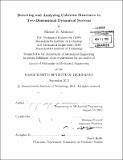Detecting and analyzing coherent structures in two-dimensional dynamical systems
Author(s)
Allshouse, Michael R
DownloadFull printable version (23.29Mb)
Other Contributors
Massachusetts Institute of Technology. Department of Mechanical Engineering.
Advisor
Thomas Peacock.
Terms of use
Metadata
Show full item recordAbstract
The identification of coherent structures enhances the understanding of transport by complex flows such as those found at the ocean surface. The rapidly developing approach of Lagrangian Coherent Structures (LCSs) is based on the identification of codimension-1 structures that are locally the strongest repelling material surfaces in forwards or backwards-time over a given time window. Current theory and methods regarding LCSs are surveyed, and we present a modified algorithm for their detection, highlighting the pros and cons of the modified approach. One beneficial aspect of the modified approach is that it is possible to classify and advect LCSs through the time window. We apply the improved detection scheme as well as the classification to a high quality, validated simulation of ocean surface flow near the Ningaloo reef along the coast of Western Australia. This region is home to the longest fringing reef in Australia, a diverse marine environment, and a growing offshore drilling industry, and understanding the surface flows will enable better informed decisions to be made in this environmentally delicate domain. In addition to applying the LCS techniques, for the first time we account for the impact of surface winds on the LCS field by creating a hybrid current-wind velocity field. While the LCS approach is based on rigorous dynamical systems theory, its reliance on an accurate velocity field restricts potential ocean applications to simulations or regions with surface velocity measurements via systems like HF radar stations. An untapped resource is the data collected from float trajectories. With the goal of eventual application to these data sets, we develop a coherent structure detection algorithm utilizing sparse trajectory data. This new approach is based on the application of tools from braid theory, which produce a simplified perspective of the mixing of two-dimensional systems that enables rapid analysis. As a first application, our braid-based approach is applied to a periodically stirred system.
Description
Thesis: Ph. D., Massachusetts Institute of Technology, Department of Mechanical Engineering, 2013. Some pages landscape orientation. Cataloged from PDF version of thesis. Includes bibliographical references (pages 211-218).
Date issued
2013Department
Massachusetts Institute of Technology. Department of Mechanical EngineeringPublisher
Massachusetts Institute of Technology
Keywords
Mechanical Engineering.